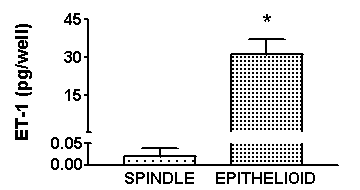| pA2 online © Copyright 2004 The British Pharmacological Society |
020P
GKT, University of London Winter Meeting December 2003 |
|
Phenotype-dependent
Endothelin-1 release from rat vascular smooth muscle cells |
|
In culture, vascular smooth muscle cells (VSMCs) from the neointima of human atherosclerotic plaques release 10 times more endothelin-1 (ET-1) than those from the healthy tunica media (Haug et al., 1996). Although there is considerable heterogeneity within VSMC populations (Hao et al., 2003) those from healthy vessels are predominately 'spindle'-shaped in vitro whereas those from areas of disease are predominately 'epithelioid'-shaped. The aim of this study was to determine if differences in VSMC phenotype may underlie the differing ET-1 release between normal and diseased vessels.
Polyclonal rat VSMC lines WKY 12-22 and WKY 3M-22 were selected to model the neointimal and medial populations of diseased and normal vessels (Bishop-Bailey et al., 2002). To isolate monoclonal populations from the mixed WKY 12-22 line, cells were plated at a density of 0.2 cells/well and incubated (37°C, 5% CO2) in DMEM plus 20% FBS. Cells were grown in 96-well plates in DMEM containing 10% FBS. When confluent, cells were serum starved in DMEM plus 0.1% BSA for 24h then incubated in DMEM containing 15% FBS for 48h. The medium was removed then ET-1 content determined by ELISA.
The release of ET-1 from WKY 12-22 cells was significantly greater than that from WKY 3M-22 cells (3.11±0.23 pg/well versus 0.17±0.1 pg/well (n=4) p<0.0001 unpaired T-test). Dilute plating yielded 10 'spindle' and 15 'epithelioid' clones from the heterogeneous WKY 12-22 population. The release of ET-1 from 'spindle'-shaped clones was less than 1% of the release from 'epithelioid'-clones (Figure 1).

Figure 1. ET-1 release from WKY 12-22 derived clones a) 'spindle'-shaped clones b) 'epithelioid'-shaped clones * denotes p< 0.001 unpaired T-test (n=5: 2 clones of each type were used)
These data show that WKY 12-22 cells, a model of the VSMC population of diseased vessels, basally release higher levels of ET-1 than WKY 3M-22 cells. Clonal populations isolated from the heterogeneous WKY 12-22 population demonstrated that the 'epithelioid' phenotype is responsible for the high basal ET-1 release. Previously ET-1 release from VSMCs has mainly been studied using the 'spindle' population from normal vessels. However, we would suggest that 'epithelioid' like VSMCs are a more appropriate model of the VSMC phenotype that predominates in vascular disease.
Bishop-Bailey, D.
et al (2002) Circ. Res., 91, 210-217.
Hao, H. et al (2003) Arterioscler. Thromb. Vasc. Biol., 23,
1510-1520.
This work was supported by the Medical Research Council.